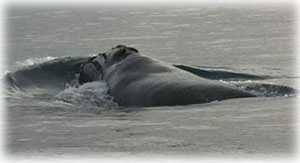 Scientists Optimistic After Sightings of Critically Endangered Whale October 02, 2004
"We saw more right whales in the Bering Sea than have been documented in the last five years combined," said Robert Pitman, NOAA fisheries marine scientist. "More importantly, we also saw three cow-and-calf pairs. Not only is the population bigger than we thought, but it may actually be growing." The extraordinary set of sightings expanded the record of known right whales in the eastern North Pacific from 13 to at least 25 individuals. The North Pacific right whale is perhaps the most endangered large whale in the world, because it was severely depleted by over-exploitation in the 1800s. Following international protection in 1931, sighting records indicate there was a small but recovering population of right whales in the eastern North Pacific. However, illegal takes of right whales by foreign commercial whaling vessels in the 1960s reduced the population to a critically low level. Since that time, sightings of right whales have been extremely rare in the eastern North Pacific, and there have been concerns that the population was headed for extinction. "In 2002, scientists documented a sighting of a right whale calf in the Bering Sea for the first time in more than a century," said retired Navy Vice Adm. Conrad C. Lautenbacher, Ph.D., under secretary of commerce for oceans and atmosphere and NOAA administrator. "Although Bering Sea right whales remain severely endangered, each new individual whale we find--especially a calf--gives us hope for their survival." Scientists took 20 biopsies - small snips of skin and blubber - that will give an individual genetic record and positive identification of individual whales in the group spotted. From a plug of skin the size of a pencil eraser, researchers at NOAA's Southwest Fisheries Science Center in La Jolla, Calif., will determine a minimum number of individuals present in the population, the sex of each whale sampled, how many of the females were pregnant and how genetically distinct the eastern North Pacific population might be. Guided by satellite tags that scientists placed on two of the right whales earlier this summer, researchers sighted the whale group in the southeastern Bering Sea just south of an area where most North Pacific right whales have been sighted in the last decade. The whale researchers on the McArthur lI are participating in the Alaska summer leg of SPLASH (Structure of Populations, Level of Abundance, and Status of Humpbacks.) The McArthur II survey, coordinated by the Southwest Science Fisheries Center, is a part of a three-year international project involving NOAA scientists along with dozens of other researchers from the United States, Japan, Russia, Mexico, Canada, the Philippines, Costa Rica, Panama, Nicaragua and Guatemala. It is designed as a systematic survey to estimate the number of humpback whales in the North Pacific. In remote Alaskan waters, the SPLASH researchers have been enjoying extraordinary success with sightings of whales more rare than humpbacks. They recently made headlines when they documented several blue whales another critically endangered species in the Gulf of Alaska. NOAA Fisheries is dedicated to protecting and preserving our nation's living marine resources and their habitat through scientific research, management and enforcement. NOAA Fisheries provides effective stewardship of these resources for the benefit of the nation, supporting coastal communities that depend upon them, and helping to provide safe and healthy seafood to consumers and recreational opportunities for the American public. NOAA is an agency of the U.S. Department of Commerce.
On the Web:
Source of News Release & Photo:
|
||
